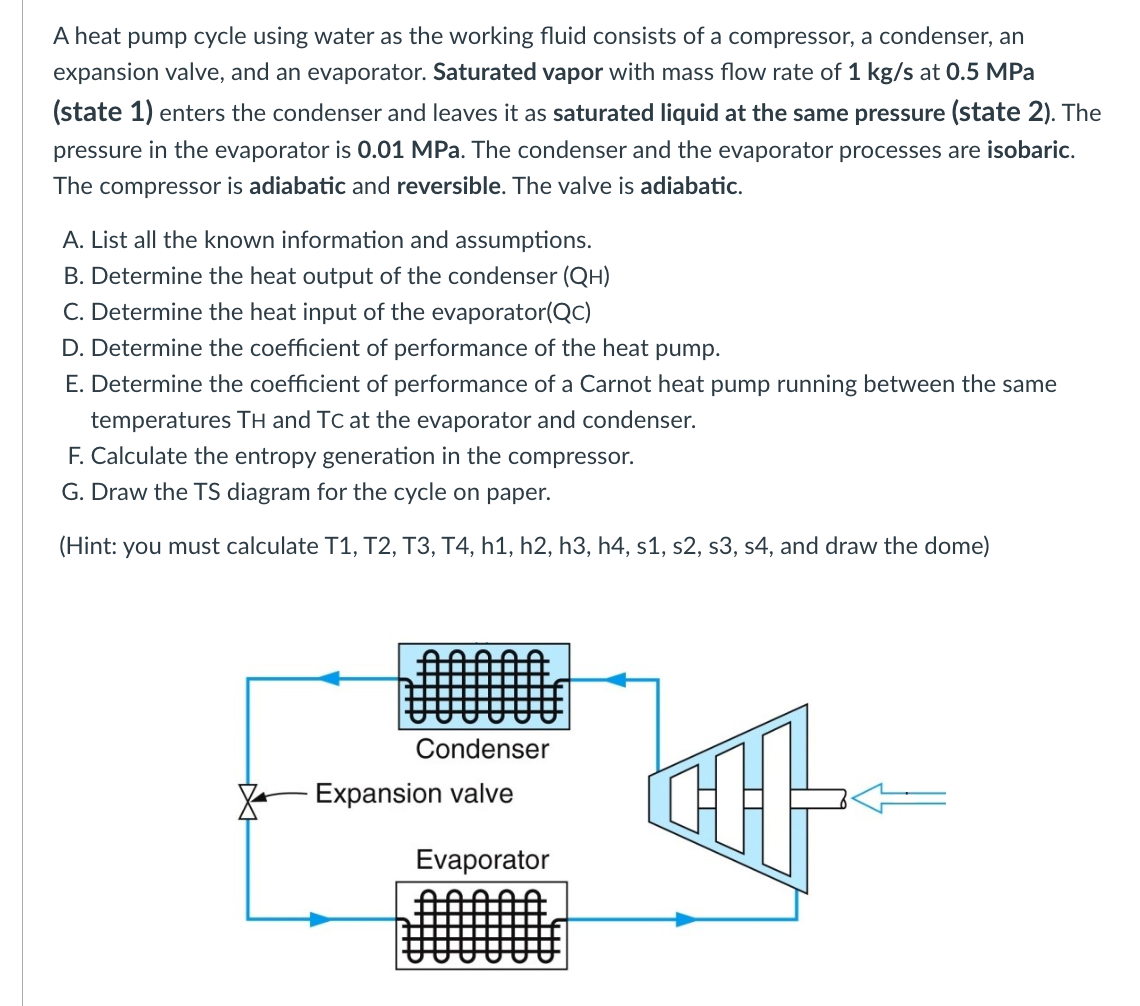A heat pump cycle using water as the working fluid consists of a compressor, a condenser, an expansion valve, and an evaporator. Saturated vapor with mass flow rate of 1 kg/s at 0.5 MPa (state 1) enters the condenser and leaves it as saturated liquid at the same pressure (state 2). The pressure in the evaporator is 0.01 MPa. The condenser and the evaporator processes are isobaric. The compressor is adiabatic and reversible. The valve is adiabatic. A. List all the known information and assumptions. B. Determine the heat output of the condenser (QH) C. Determine the heat input of the evaporator(Qc) D. Determine the coefficient of performance of the heat pump. E. Determine the coefficient of performance of a Carnot heat pump running between the same
A heat pump cycle using water as the working fluid consists of a compressor, a condenser, an expansion valve, and an evaporator. Saturated vapor with mass flow rate of 1 kg/s at 0.5 MPa (state 1) enters the condenser and leaves it as saturated liquid at the same pressure (state 2). The pressure in the evaporator is 0.01 MPa. The condenser and the evaporator processes are isobaric. The compressor is adiabatic and reversible. The valve is adiabatic. A. List all the known information and assumptions. B. Determine the heat output of the condenser (QH) C. Determine the heat input of the evaporator(Qc) D. Determine the coefficient of performance of the heat pump. E. Determine the coefficient of performance of a Carnot heat pump running between the same
Refrigeration and Air Conditioning Technology (MindTap Course List)
8th Edition
ISBN:9781305578296
Author:John Tomczyk, Eugene Silberstein, Bill Whitman, Bill Johnson
Publisher:John Tomczyk, Eugene Silberstein, Bill Whitman, Bill Johnson
Chapter45: Domestic Refrigerators And Freezers
Section: Chapter Questions
Problem 2RQ: The operating condition for the single compressor in a household refrigerator is the lowest box...
Related questions
Question

Transcribed Image Text:A heat pump cycle using water as the working fluid consists of a compressor, a condenser, an
expansion valve, and an evaporator. Saturated vapor with mass flow rate of 1 kg/s at 0.5 MPa
(state 1) enters the condenser and leaves it as saturated liquid at the same pressure (state 2). The
pressure in the evaporator is 0.01 MPa. The condenser and the evaporator processes are isobaric.
The compressor is adiabatic and reversible. The valve is adiabatic.
A. List all the known information and assumptions.
B. Determine the heat output of the condenser (QH)
C. Determine the heat input of the evaporator(Qc)
D. Determine the coefficient of performance of the heat pump.
E. Determine the coefficient of performance of a Carnot heat pump running between the same
temperatures TH and TC at the evaporator and condenser.
F. Calculate the entropy generation in the compressor.
G. Draw the TS diagram for the cycle on paper.
(Hint: you must calculate T1, T2, T3, T4, h1, h2, h3, h4, s1, s2, s3, s4, and draw the dome)
Condenser
Expansion valve
Evaporator
Expert Solution
This question has been solved!
Explore an expertly crafted, step-by-step solution for a thorough understanding of key concepts.
Step by step
Solved in 5 steps with 11 images

Knowledge Booster
Learn more about
Need a deep-dive on the concept behind this application? Look no further. Learn more about this topic, mechanical-engineering and related others by exploring similar questions and additional content below.Recommended textbooks for you

Refrigeration and Air Conditioning Technology (Mi…
Mechanical Engineering
ISBN:
9781305578296
Author:
John Tomczyk, Eugene Silberstein, Bill Whitman, Bill Johnson
Publisher:
Cengage Learning

Principles of Heat Transfer (Activate Learning wi…
Mechanical Engineering
ISBN:
9781305387102
Author:
Kreith, Frank; Manglik, Raj M.
Publisher:
Cengage Learning

Refrigeration and Air Conditioning Technology (Mi…
Mechanical Engineering
ISBN:
9781305578296
Author:
John Tomczyk, Eugene Silberstein, Bill Whitman, Bill Johnson
Publisher:
Cengage Learning

Principles of Heat Transfer (Activate Learning wi…
Mechanical Engineering
ISBN:
9781305387102
Author:
Kreith, Frank; Manglik, Raj M.
Publisher:
Cengage Learning